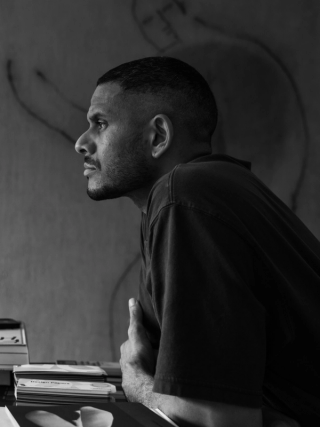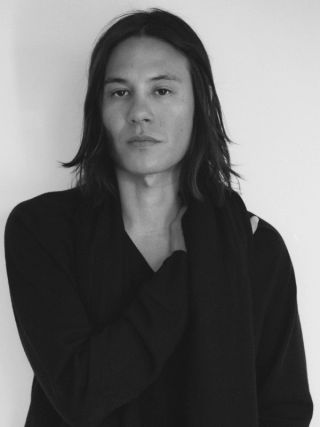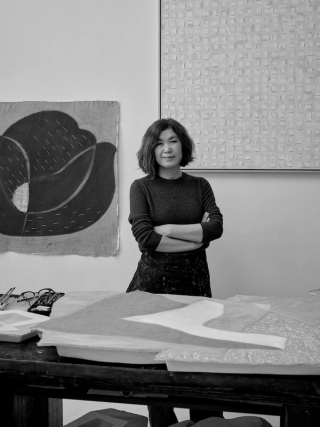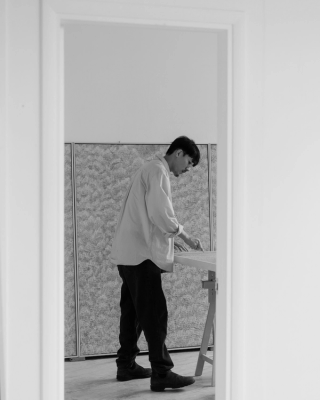Featured artworks



 LA Gallery
LA GalleryWill CalverA Tower of Pebbles, 2025

 LA Gallery
LA GalleryWill CalverRed Pear and Matchstick, 2025



 LA Gallery
LA GalleryWill CalverClementine, 2025





 LA Gallery
LA GalleryWill CalverTwo Peaches, 2025
News
- 11.13.25
New Work — Jean-Baptiste Besançon
Read moreThese paintings by Jean-Baptiste Besançon represent an ongoing exploration of intuitive mark-making and spontaneous composition. Departing from his usual palette, Besançon introduces lighter, softer tones that amplify the interplay between shapes, while alternating between translucent washes and heavily textured applications of paint. Working without preconception, he allows each piece to evolve through a reciprocal exchange — the painting gradually returns something to him that exists beyond language, signalling its completion. This dialogue between artist and work extends outward to the viewer, who encounters an immersive experience of color and depth, drawn into their vastness and moved by the emotional resonance of their palette.
- 10.01.25
Ancestral Futures Playlist
Read moreChidy Wayne has created a playlist to accompany his solo show, Ancestral Futures, at Francis Gallery.
- 05.25.25
Non-Reification — New Paintings by Woo Byoung Yun
Read moreArtist Statement: Titled Non-reification, this collection reflects my desire to portray human existence through the intangible. Drawing from the Frankfurt School’s concept of reification — particularly the process by which human relationships are commodified and individuals are reduced to functional, even replaceable, entities — these paintings strive to go beyond the realm of the material and engage in the sensorial. Non-reification reveals a world not through visible form, but through resonance — intimate, invisible, and vibrational.
Artists
- Andrea Walsh

Working in ceramics, glass and metal, Andrea Walsh creates objects that celebrate the ancient and alchemical qualities of her materials. By exploring ideas of containment and value through her considered, tactile objects, she prompts viewers to engage in a spontaneous interaction with her work.
- Aram Saroyan

Saroyan’s work has been featured in museums and galleries in the US, Europe, India and the Middle East. In Los Angeles, his work has been featured in shows at LACMA, Commonwealth and Council, the As-Is Gallery, and the Hammer’s Biennial Made in LA: a, the, though, only, for which he wrote the subtitle.
- Armando Chant

Combining embroidered linen with pigment washes and etching, Chant uses techniques of erasure and negation to arrive at ambiguous, atmospheric landscapes. His work focuses on the inherent potential of the in-between, a place of imaginative engagement and a nascent state of emergence.
- Ash Roberts

The work of Helen Frankenthaler and the Color Field painters of the 1960s and 70s have been influential to Roberts, whose paintings feature large swaths of uninterrupted color – a melange of different tones which seem, suddenly, to crystallize into areas of figuration: a flower, leaf or lily pad appearing from the depths.
- Berend Boorsma

Each piece “starts with chaos, where anything can happen,” and slowly evolves over days and months, becoming more refined and distilled to its essence. Following Taoist principles, Boorsma tries “only to act when it comes from within. It is a process in which the painting finds its own form.”
- Chidy Wayne

His practice addresses fundamental questions such as identity and inner conflict through a gestural, material-based figuration that incorporates oils, acrylics, textured surfaces, and sculptures in wood, iron or plaster.
- Chris Liljenberg Halstrøm

There is an intrinsic connection to the passage of time in Halstrøm’s work. Her laborious stitches force the viewer to pause, and to pore over the work’s surface. “I feel that my final pieces reflect a sense of time and an anonymous presence of effort,” she says. “There are no short cuts."
- Christina Kim of dosa

Kim draws on traditional handwork techniques, particularly in India, Mexico, and Colombia, engaging local artisans and communities in long term collaborations.
- David Quinn

Quinn's works appear as visual haikus, sharing a universal form and offering endlessly variable imagery; each a unique piece, yet part of a wider whole. The familiar format allows Quinn to focus entirely on the painting itself, moving beyond conscious thought to reach an instinctive, meditative state.
- Ekun Richard

Ekun Richard relishes rich, earthy tones that celebrate the physicality of nature. Working with oil on canvas, his pieces exhibit a natural warmth and gentle sense of wit.
- Fernando Casasempere

Through a fascination with the imprint left by humans on the earth, Casasempere draws on archaeology, geology, landscape and classical and modern architecture to subvert sculptural archetypes, while speaking to urgent global ecological and social concerns through the lens of his native Chile.
- Garcé Dimofski

As designers, interior architects, and architects, Clio and Olivier stand out for their passion for craftsmanship and raw materials, which they harmoniously incorporate into projects that celebrate the human touch and local know-how.
- JAMESPLUMB

For Russel and Plumb, the distinction between art and design is blurred and interchangeable, both in their own work and in their perception of the world. A table becomes an artwork, or a sculpture becomes a chair.
- Jean-Baptiste Besançon

To be in contact with the canvas can be “a fight” for Besançon, evoking strong emotions and “strange sensations”. His practice is not a direct response to personal events, and he avoids offering a rigid framework in which the art should be understood, preferring to contextualise painting as its own language.
- Jessica Woo Jung Ghil

For Ghil, painting serves as an existential exploration of an inner sanctuary—an undisturbed realm untouched by the constant stimuli of the external world. This process acts as a form of inner self-portraiture, with the quietude or 'jeongjeok' symbolising a personal state the artist aspires to reach and inhabit.
- John Zabawa

Spanning minimalist presentations and classical still lives, painter John Zabawa is not married to any school or style – instead, he seeks the best way to convey his message, to express something of himself and his process.
- Koo Bohnchang

Koo Bohnchang dedicates much of his practice to capturing the passage of time. His celebrated series Vessels, taken over the course of 13 years, studies the frailty and beauty of Joseon-era baekja which Koo visited in major museums around the world.
- Liam Stevens

London-based artist Liam Stevens works in layered pigment washes with pencil on canvas, and constructed reliefs. His creations are composed of repeated lines and forms, creating a sense of rhythm in the negative space.
- Mari-Ruth Oda

Oda’s serene, emotive sculptures reflect her fascination with fluid lines and natural forms, in materials such as jesmonite, resin and ceramics. “My work says more than I can with words.”
- Myoung Ae Lee

Lee’s work — which comprises oil paint on canvas, as well as collages of natural fiber, fabric, and plaster on shaped canvas — explores the delicate relationships of individual entities as they relate to the whole, translated by way of the broad and recurring theme of coexistence.
- Nadia Yaron

Sculptor Nadia Yaron carves weighty, organic forms from wood, stone and metal in her home studio in Hudson, New York. Her pieces are hewn with chainsaws and grinders, a necessarily violent practice that contrasts with the tranquil sculptures.
- Nancy Jiseon Kwon

Nancy Jiseon Kwon creates ceramics, textiles and works in glass that are rooted in tradition and ritual. From ancient Korean stoneware and hemp burial gowns, to Etruscan votive offerings and Neolithic petroglyphs, her pieces are informed by a long tradition of ceremonial objects created from organic materials.
- Nicky Hodge

Hodge creates her abstract paintings and drawings with immediacy and intuition, working quickly and performatively to make sweeping, gestural marks. Using acrylic diluted with water on raw, untreated canvas, she often softens the surface with a brush, blurring calligraphic gestures into ethereal forms.
- Office of BC, Lindsey Chan

OFFICE OF BC is a Los Angeles based multidisciplinary design firm led by Lindsey Chan and Jerome Byron, specializing in interior design and interior architecture for commercial and residential spaces.
- Paul Philp

Paul Philp is a studio potter who has been making ceramics for over 50 years. Building everything by hand, he is free to create the forms his imagination requires, beyond the restraints of a potter’s wheel.
- Rahee Yoon

Yoon brings her experience in metalwork, textiles, ceramics, woodworking and resin-casting to create enigmatic objects that sit at the intersection of art and design. She studied arts and crafts at Sookmyung Women’s University in Seoul and opened her own studio in 2017.
- Rosemarie Auberson

Auberson is inspired by the entire visual world, particularly the colours she finds in nature, travel, and film, and the physicality and materiality of the paintings themselves. Her compositions are intentionally open, an invitation to the viewer to become an active participant in their resolution.
- Sarah Kaye Rodden

Kaye Rodden’s sculptural pieces are grounded in a deep appreciation for her raw material, which range from leather of varying shades to ancient bog oak. “My great great grandfather was a tanner and saddler in Yorkshire, and my desire to work with traditional materials, particularly leather, stems from this connection with my past."
- Will Calver

In studying the interactions between light, form and colour, British artist Will Calver’s still lifes convey the quietude and subtle monumentality of everyday objects.
- Woo Byoung Yun

Combining science, philosophy and art – as they often were in the past – Woo has a particular interest in the mechanics of light. He draws upon the discoveries of his own time, in particular, quantum mechanics and the recent revelation that light is both a particle and a wave.
- Yoona Hur

Yoona Hur is a ceramic artist based in Seoul and New York. Inspired by the full breadth of Korean ceramic history, from ancient earthenware to the white porcelain of the Joseon dynasty, her pieces both preserve and reinterpret this cultural heritage.
